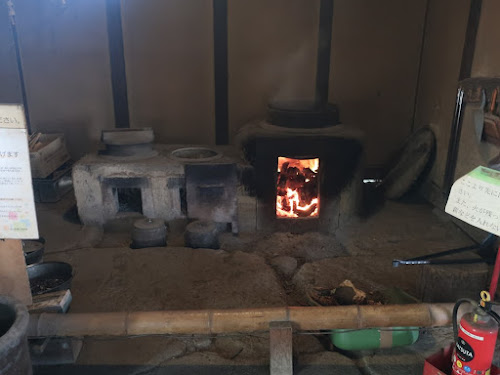This
museum is in the Nishihara Natural Forest which is about 40km north of Tokyo. Old houses and a school are also exhibited in this forest. The catchword of Miyashiro
town is “To live with water and greenery”, because there are Tone River and
Musashino forest.
Exhibits
of ancient cuisines attract me. Those are not good-looking but I am sure that
the family dinner was fun. The picture of the trip to the Kumano Shrine, in
which men enjoy a lot, also attracts me. I took photos under the permission.
東京の北40km、西原自然の森の中に移築された古民家や学校とともにある。宮代町は、古利根川の清流と武蔵野の緑に恵まれ「水と緑に生きる」をテーマにしている。
面白かったのが、古代の食事の展示。華やかではないが、家族にとっては、皆で食べられるのが、うれしいひとときだったと思う。男たちが熊野に詣でた絵の絵馬には、旅の楽しみが溢れていた。許可申請して撮影。
Ancient era、縄文・弥生時代
The models of foods of the Jomon period
(more than three thousand years ago); Those are dumplings and cookies of nuts,
meat balls and soup of oysters or clams.
縄文時代の食を想定したの模型。木の実をすり潰して調理した団子やクッキー、動物の肉の団子、宮代町まで、海水が来ていたので牡蠣とハマグリのスープのメニューになっている。
 |
Simple accessories in the Jomon period.
縄文のシンプルなアクセサリー類
|
The model of a staple food of the Yayoi
period (around two thousand years ago) when rice farming started in Japan.
People still ate millet.
弥生時代の主食の模型。稲作が始まったが、縄文時代と同じく粟やヒエも食べられていたという。
Acorn nut dumplings are on the Yayoi-style
clay bowl.
手が込んだ弥生式土器にはどんぐり餅が載せられている。
The soup of shijimi clams, which doesn’t
look good, but maybe tastes good because it is a shellfish soup.
シジミのスープ。おいしそうには見えないけど、貝のスープだから美味だったのでしょう。
Reference (Exhibits of Japanese food since the primitive age、日本の食事の展示:原始時代から):MAHORON(Fukushima
Cultural Property Centre, Shirakawa Branch)、まほろん(福島県文化財センター・白河館)
Edo period (1603~1868)、江戸時代
Ema board of a trip to the Kumano Shrine
attracts me.
目を引いたのが熊野参詣を描いた絵馬
Enlarged ema board: It was offered to the
local shrine in 1815 by eleven men, because they completed a safe trip to
Kumano Shrine which is 450km away from their village in direct distance. Kumano
are is a very popular tourist destination even now.
I
think it was a cold season because farmers traveled in winter which is an
agricultural off-season. BUT they are half-naked.
Although they are scruffy, they are full of
happiness and excitement. I can feel how they enjoyed the trip and how they
felt relief after returning to their village.
絵馬の拡大:姫宮神社に奉納された絵馬の複製であるがなんとも楽しい。
1815年に村の男11人が無事に熊野詣でを終えて奉納した。笠に百と書いてあるので百間村の者と分かるという。行李を持った旅姿だが、肌むき出しの男たちだが、農家だとしたら冬の旅だと思う。本当なのか筋肉を強調したのか、半裸姿で、むさ苦しいといえばむさ苦しいが、直線距離で450km離れた熊野に着いた嬉しさ、無事に帰村した嬉しさがあふれている。
This town is in a marsh area, so people
had struggled to develop new fields.
低湿地だったため、堀をさらったり新田開発をしたり、常に土地改良をしていたようだ。
The picture of the US fleet which came to
Japan in 1853 and Japanese samurai troops. It triggered the disruption of the Tokugawa
shogunate and the Edo period.
岩崎家に残されている黒船来航の図。守備についた諸藩の位置も書かれている。そして明治になる。
Meiji period (1868-1912) 、明治時代
Christianity was prohibited in the Edo period,
but it was allowed in the Meiji period. Wato church in this town is the oldest
in Saitama prefecture.
和戸キリスト教会は県内で最も古いらしい。
Kato’s house and Ancient house、加藤家住宅と竪穴式住居
Kato family was a village head in the Edo
period. This house (right) was built around 1813. The ancient house (left) was
rebuilt here.
1813年頃に建てられたと推定される名主の加藤家住宅。左側は縄文時代の竪穴式住居だ。
Surprisingly enough, firewood is burned in
a big kitchen stove. Smoke spread everywhere in the house, so I can realize the
inhouse condition back then. In Shikoku, I saw a smoke barrier wall of an old
house. Perhaps it worked well.
加藤家住宅では、驚いたことにかまどに火を入れている。広い家中がもうもうとして、当時の様子を実感できた。徳島・松茂町の煙返しという垂れ壁は効果的かもしれない。
Kitchen (Earthen floor)、土間の台所
Smoky living space、煙が漂う居間
Firewood is also burned in the ancient
house. The smoke is exhausted from the top.
竪穴式住居でも火をたいており、屋根から排気する。
Saitou’s house、旧齋藤家住宅
This building was made in the Meiji
period.
こちらは明治時代の建物
Talismans for fire-protection and theft-protection
are attached near the entrance door.
玄関を入ったところには、火防、盗賊除けの御札がしっかりと貼られている。他にも、明治に学校として使われていた旧進修館も移築されていた。
Miyashiro town、宮代町内
I visited an onsen hot spring of the neighboring
town Sugito. Utano-yu is popular because of a large open-air bath.
お隣の杉戸町の日帰り温泉・雅楽(うた)の湯へ。露天が広く人気です。
Visited in April, 2019
Website: www.town.miyashiro.lg.jp/category/10-0-0-0-0.html
(in Japanese), accessed in June, 2020
動画を含め大量のデータがアップされています。清次郎さんの旅日記(1841)など、面白い。お勧めです。
Previous post (Local museum in the same prefecture, Saitama):
Next post (Local
museum just seven kilo-meters away from here、近くの資料館):




















Comments
Post a Comment